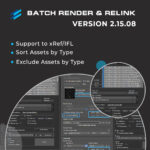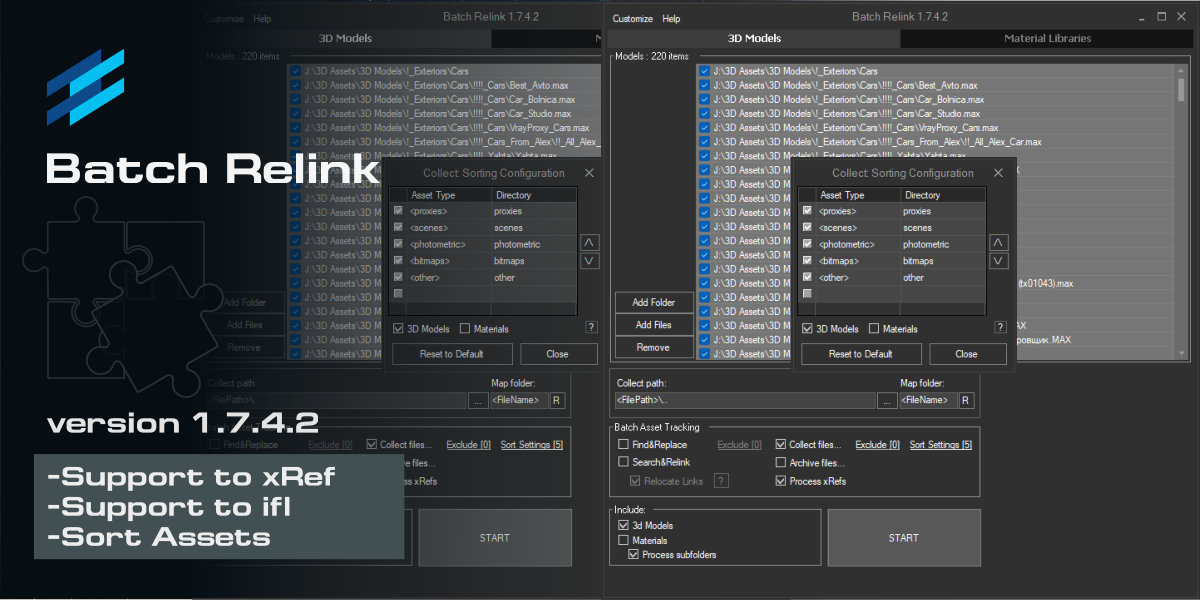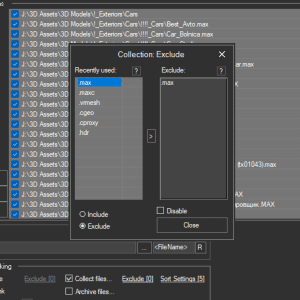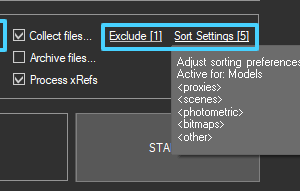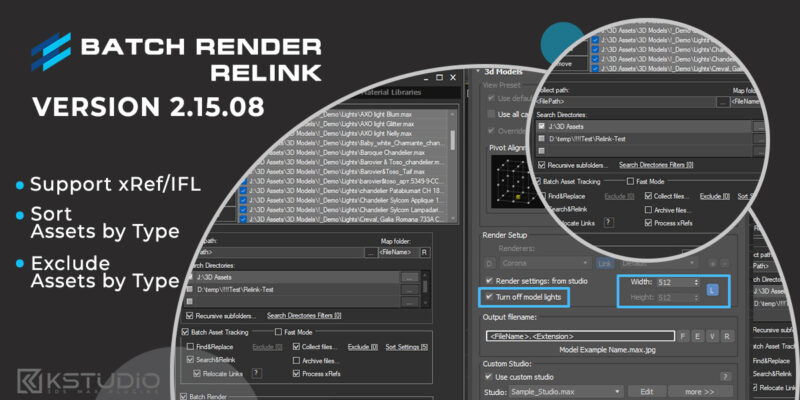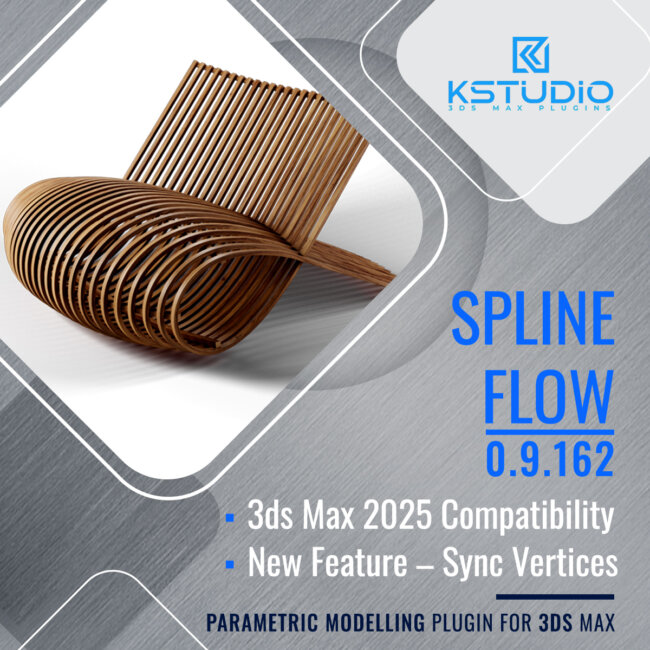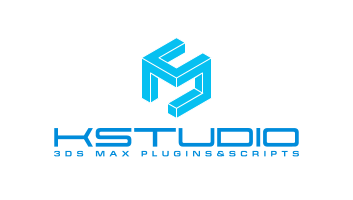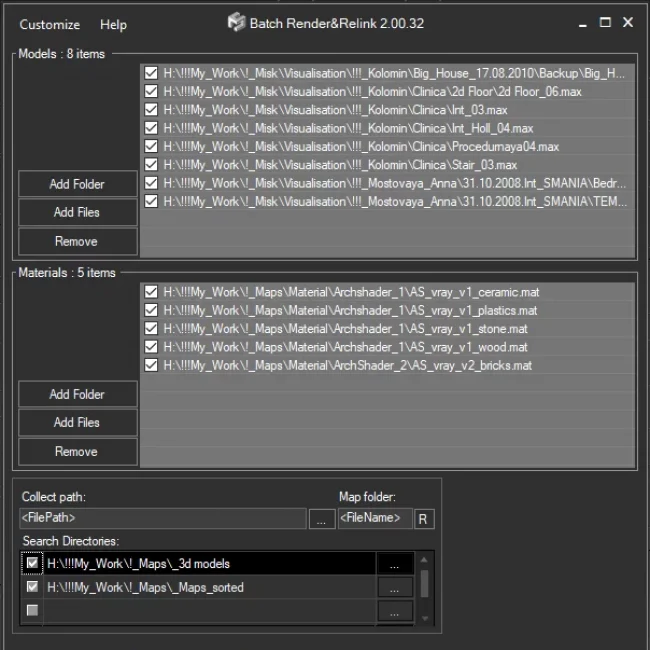- March 12, 2024 at 14:56 #40766
- Do not copy the duplicate, and leave the link to its current location
- Relink the file to a new path
- Replace the existing file and relink to the new path
- Copy the asset, rename, and relink using a new path and name.
This option allows keeping both files - Adds support for xRef files
- Adds support to search/relink/collect/archive the content of IFL files
- Adds an ability to include/exclude directories from searching by mask
- Adds an ability to sort assets by asset type/extension
- Adds an ability to exclude files from collecting by extension
- Adds an ability to exclude files from renaming by extension
- "Duplicate Asset Replacement" dialog UI improvements
- Some interface improvements, changes, and fixes
- Fixes an issue with relocating some paths
- Fixes an issue with logging
Batch Relink is an indispensable application for organizing and managing assets in batch mode across numerous 3D Max files, including models and material libraries.
It enables users to search for missing assets, relink resource paths, collect assets into one folder for models and materials, and archive them for backups or rendering submissions.
The program also offers support for mass renaming links by mask, making asset management more convenient.
With the latest update, the program’s capabilities have expanded to include support for xRef files, IFL (Image File List), sorting assets by type, relocating assets, and more.XREF FILES SUPPORT
The updated version of Batch Relink now supports xRef files.
This expands the program’s capabilities, allowing work not only with models but also with project scene files.
Users can now relink all assets, including those part of xRef scenes, regardless of their nesting level.
IFL files support
Batch Relink now accommodates IFL files, enabling the search and copying of raster files specified in .ifl files.
An IFL (Image File List) file constructs an animation by listing single-frame bitmap files for each rendered frame. Assigning an IFL file as a bitmap lets rendering step through each specified frame, creating an animated map.SORT ASSETS BY ASSET TYPE/EXTENSION
The program now offers the option to sort assets during collection, aiding in the better organization of assets.
This feature allows for sorting assets by types, such as placing proxies and textures in separate folders.
Users can also choose how to sort assets by extension, for instance, separating HDRI files from other bitmaps.
EXCLUDE FILES FROM COLLECTING BY EXTENSION
Excluding files by extension from the collection process adds flexibility, allowing users to leave large files, such as Proxy or HDRI, in their original locations.
Additionally, when gathering all assets into a single folder, users can exclude xRef files from being copied.Assets can also be excluded based on their name, with support for the
wildcard “*” to broaden the exclusion criteria.
All previously utilized options are conveniently stored in a list on the left side, making it easier to reuse them.Pay attention that you can quickly assess which of the additional parameters are used
It’s important to note that during the archiving process, file exclusion settings are disregarded.
EXCLUDE FILES FROM RENAMING BY EXTENSION
The functionality for renaming assets has been enhanced, there is now the ability to exclude files from being renamed based on their extension.
Plans are in place to significantly broaden the capabilities for renaming assets in batch mode in the future.
INCLUDE/EXCLUDE DIRECTORIES FROM SEARCHING BY MASK
The feature to exclude or include directories in the search by using a mask greatly streamlines the asset selection process, helping to prevent confusion between textures and previews.
For instance, if a texture’s name matches that of a model’s preview, the ability to exclude directories containing the words THUMBNAIL* or PREVIEW* from the search is beneficial. Conversely, directories can be specifically included in the search by using masks like TEXTURE* or MAP*.
All previously used options are stored in the list on the left, so users can reuse saved filters at any time.
Duplicate Asset Replacement
The improved interface of the dialog for resolving duplicate asset conflicts allows easy selection between several processing options, providing flexibility in resolving file name conflict issues.
Some assets may have the same names but different content.
To resolve the name conflict issue when copying, we offer the Duplicate Asset Replacement dialog. This dialog will show previews of duplicates and information about them to facilitate the choice of what to do with the duplicate.
The following options are available:The new version offers an improved interface for this dialog and a new feature – you can specify which option you wish to apply to the entire session. This means that the selected option will not become default, but your choice will be applied to all duplicates during this asset collection session.
Relocate capability
The relocate feature enhances asset management by enabling the relinking of assets to a new folder, which is particularly useful for library reorganization or setting up different rendering options.
While the default search targets assets marked as “missing,” there are scenarios where it’s beneficial to relink assets to a different folder.
This may be necessary, for example, for library reorganization or when creating multiple rendering variations with different textures stored in various directories.To utilize this functionality, activate the “Relocate Links” option and define the new destination for the scene assets or material libraries by adding a folder to the list. It’s possible to add multiple folders to this list and change a priority for relocation based on the order of the folders– the higher the folder, the higher its priority, and the search will primarily take place in this folder.

Reorder Search directories with drag&drop Adjusting the order of these directories is straightforward; simply drag and drop a directory within the list to change its position. If you wish to exclude a folder from the search, just remove it from the list or uncheck the box next to it.
TIP: For efficient asset management, consider combining several batch processing features. For instance, you can activate the search, relocate, and collect assets options simultaneously for a streamlined workflow.
Archiving Models and material libraries
Archiving projects and assets is also an important part of working on projects.
It’s essential to regularly back up your projects and resource libraries to safeguard against data loss due to technical failures or other unforeseen issues. Once a project is completed, moving it to an archive ensures its preservation and facilitates easy access in the future.Beyond mere backup, archiving will help in transferring projects and assets to a new computer or sending them to a render farm for processing. Utilizing relative paths for assets during the archiving process streamlines the transfer of projects to new environments or external rendering services, eliminating the hassle of path conflicts and simplifying setup on the receiving end.
Some features of archiving:
– File exclusion settings are not considered during the archiving process. This ensures that all necessary assets are included in the archive, regardless of any exclusion rules set during regular asset management operations.– In the event of duplicate file names, the archiving system automatically renames duplicates to prevent conflicts. This feature maintains the integrity of the archive by ensuring that each asset is uniquely identified, thus avoiding any potential issues during restoration or when the project is transferred to another system.
By adhering to these practices, you can ensure that your projects and assets are securely archived, easily transferable, and protected against loss, thereby supporting a smooth workflow and project continuity.
Extended logging
Extended logging capabilities have been introduced to enhance the monitoring of batch-processing activities.
After completing batch processing, you can access detailed logs through the menu path Customize => Logging => View Logs.
These log files now contain comprehensive information about the batch processing, including the type of file (MAT, MAX, MAX (xRef)), the version of 3ds Max with which the file was saved, and the active renderer for MAX files.
This detailed logging allows you to identify files that remain missing and, if necessary, initiate a new search to locate them.We’re excited about this update and believe it will significantly improve your experience with Batch Relink.
We’re eager to hear your feedback and learn about the features you’d like to see in future updates.
Whether it’s improvements or entirely new functionalities, your suggestions are invaluable in making your workflow smoother and more efficient.
Please share your thoughts and ideas in the comments below. Your input is crucial to us, and we look forward to hearing from you!The full list of changes for this version is given below.
$14.00Add to Cart
Read about the Latest Version
Related to "Batch Relink version 1.7.4.2"
You must be logged in to reply to this topic.
 Translate
Translate

